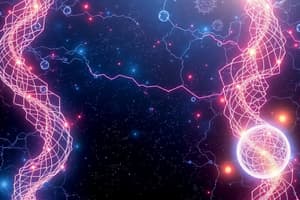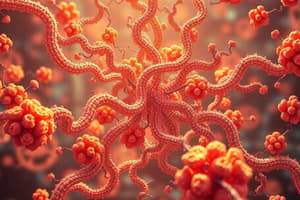Podcast
Questions and Answers
What is the primary source of high-energy phosphate in aerobic organisms?
What is the primary source of high-energy phosphate in aerobic organisms?
- Creatine phosphate
- Glycolysis
- Oxidative phosphorylation (correct)
- Citric acid cycle
Which compound can directly accept phosphate to form ATP?
Which compound can directly accept phosphate to form ATP?
- Succinate
- ADP (correct)
- Lactate
- Creatine phosphate
In which step of the citric acid cycle is high-energy phosphate generated?
In which step of the citric acid cycle is high-energy phosphate generated?
- Malate synthase step
- Isocitrate dehydrogenase step
- Fumarase step
- Succinate thiokinase step (correct)
What role does adenosine triphosphate (ATP) play in bioenergetics?
What role does adenosine triphosphate (ATP) play in bioenergetics?
What role do phosphagens play when ATP is rapidly utilized for muscular contraction?
What role do phosphagens play when ATP is rapidly utilized for muscular contraction?
Which process is primarily responsible for ATP production from electron transfer?
Which process is primarily responsible for ATP production from electron transfer?
Which of the following statements about ATP/ADP ratio is true?
Which of the following statements about ATP/ADP ratio is true?
What consequence can occur due to the malfunction of thyroid hormones?
What consequence can occur due to the malfunction of thyroid hormones?
What is the main effect of energy imbalance related to malnutrition?
What is the main effect of energy imbalance related to malnutrition?
What does a negative ΔG indicate about a reaction?
What does a negative ΔG indicate about a reaction?
How does excess energy storage manifest in modern society?
How does excess energy storage manifest in modern society?
Which of the following compounds primarily serves as a substrate for the TCA cycle?
Which of the following compounds primarily serves as a substrate for the TCA cycle?
What must be true for a reaction with a positive ΔG0 to proceed in the forward direction?
What must be true for a reaction with a positive ΔG0 to proceed in the forward direction?
What is the relationship between ΔG and equilibrium?
What is the relationship between ΔG and equilibrium?
Which coenzymes are generated during the TCA cycle?
Which coenzymes are generated during the TCA cycle?
In the equation ΔG = ΔG0 + RT ln[B] / [A], what do [A] and [B] represent?
In the equation ΔG = ΔG0 + RT ln[B] / [A], what do [A] and [B] represent?
What condition leads to a negative value of RT ln([B]/[A])?
What condition leads to a negative value of RT ln([B]/[A])?
What is the significance of free energy changes in bioenergetics?
What is the significance of free energy changes in bioenergetics?
What happens when ΔG equals zero?
What happens when ΔG equals zero?
Which of the following describes an exergonic reaction?
Which of the following describes an exergonic reaction?
What is indicated by a standard free energy change (ΔG0) that is positive?
What is indicated by a standard free energy change (ΔG0) that is positive?
What is the value of ΔG under standard conditions when the natural logarithm of the ratio of products to reactants is zero?
What is the value of ΔG under standard conditions when the natural logarithm of the ratio of products to reactants is zero?
Under which conditions can ΔG0 predict the direction of a chemical reaction?
Under which conditions can ΔG0 predict the direction of a chemical reaction?
What does the equilibrium constant (Keq) represent in a reaction A ⇄ B?
What does the equilibrium constant (Keq) represent in a reaction A ⇄ B?
What type of process does an endergonic reaction represent?
What type of process does an endergonic reaction represent?
How do endergonic processes typically obtain the necessary energy to occur?
How do endergonic processes typically obtain the necessary energy to occur?
What characterizes the overall net change in a coupled exergonic–endergonic reaction system?
What characterizes the overall net change in a coupled exergonic–endergonic reaction system?
Which components make up Adenosine Triphosphate (ATP)?
Which components make up Adenosine Triphosphate (ATP)?
What type of reactions primarily result in catabolism?
What type of reactions primarily result in catabolism?
What is the primary way ATP is produced in the cell?
What is the primary way ATP is produced in the cell?
Which of the following statements about ATP is true?
Which of the following statements about ATP is true?
What is the result of hydrolyzing ATP to ADP and inorganic phosphate (Pi)?
What is the result of hydrolyzing ATP to ADP and inorganic phosphate (Pi)?
Which statement regarding ADP is correct?
Which statement regarding ADP is correct?
What is the role of high-energy phosphates in the cell?
What is the role of high-energy phosphates in the cell?
What is the correct reaction for interconversion involving ATP?
What is the correct reaction for interconversion involving ATP?
Which high-energy compound can be used to regenerate ATP?
Which high-energy compound can be used to regenerate ATP?
Which of the following compounds does NOT play a role in cellular energy transfer?
Which of the following compounds does NOT play a role in cellular energy transfer?
Flashcards are hidden until you start studying
Study Notes
Bioenergetics
- Bioenergetics describes the flow of energy in biological systems.
- Changes in free energy (ΔG) highlight the feasibility of a reaction.
- A negative ΔG indicates an exergonic reaction, releasing energy, and proceeding spontaneously.
- A positive ΔG indicates an endergonic reaction, requiring energy input.
- A ΔG of zero indicates equilibrium.
- ATP serves as the primary energy carrier in biological systems, transferring energy from energy-producing processes to energy-consuming processes.
ATP and Its Role
- ATP consists of adenine, ribose, and three phosphate groups.
- The hydrolysis of ATP to ADP releases energy, driving various cellular processes.
- The adenylate kinase reaction interconverts ATP, ADP, and AMP.
- ATP can donate phosphate groups to other compounds, like glucose, forming ADP.
- ADP can accept phosphate groups from compounds like phosphocreatine, forming ATP.
Generation of ATP
- There are three main sources of high-energy phosphates (~℗) for ATP generation:
- Oxidative phosphorylation: The primary source in aerobic organisms, generating ATP in the mitochondria.
- Glycolysis: Produces two molecules of ATP per glucose molecule.
- Citric acid cycle: Generates one molecule of ATP per cycle.
Phosphagens
- Phosphagens, like creatine phosphate, act as energy stores, buffering ATP concentrations.
- They donate phosphate groups to ADP, replenishing ATP during periods of high energy demand.
Importance of ATP/ADP Cycle
- The ATP/ADP cycle plays a crucial role in energy transfer within the cell.
- It ensures the continuous supply of ATP for various metabolic processes.
Studying That Suits You
Use AI to generate personalized quizzes and flashcards to suit your learning preferences.




